Basketball, invented in the winter of 1891-1892 inside a gymnasium at Springfield College, now has been evolved as one of the most famous sports around the world. Almost 110 countries have adopted this game in which Russia, Great Britain, Germany, Spain and parts of Asia are included. But surely you have mostly heard the name of the NBA (National Basketball Association) , which is the lucrative league of America.
Just like other sports, basketball is also made of strict and clearly defined rules and regulations. These rules and regulations ensure the smooth and fair game flow. You may buy a book, but it will be difficult to understand and memorize the rules by highlighting things from hundreds of pages.
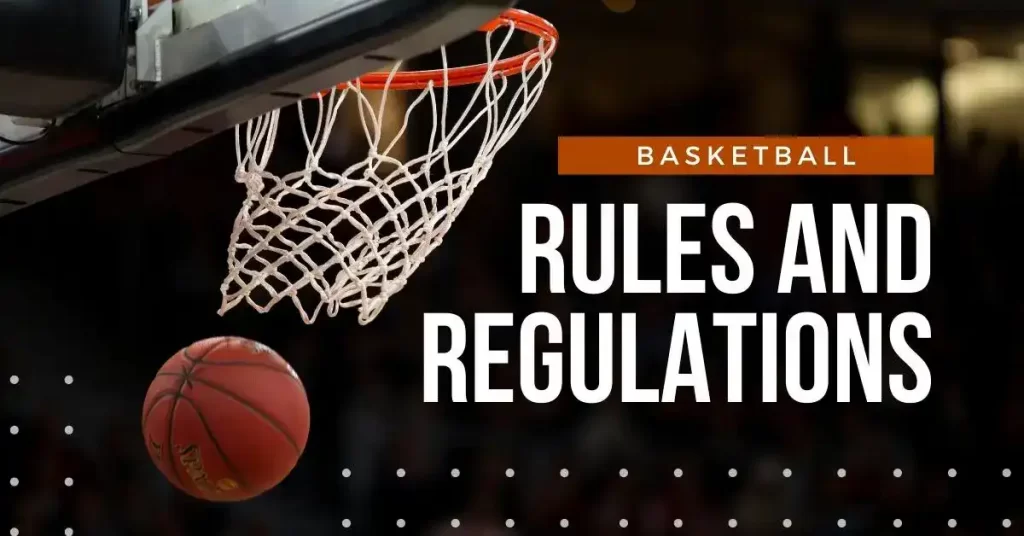
So, today in this article I am going to make you aware of the all basic\general and specific detailed rules of the basketball game, without any confusion.
General Rules and Regulations in Basketball for Beginners
Here are some general rules and regulations about basketball that every beginner must know well.
- Playing activity of this game has to stay limited within the periphery of the basketball court.
- You can throw the basketball in any direction but you have to dribble the ball all the time.
- You can use only one hand for dribbling the ball along with you as you run.
- You must use your hands to catch the ball and no other parts of the body can be used.
- You must not push, hit, elbow, shoulder or strike your opponent during any time in the game.
- If a player gets the basketball through the hoop, the team will get the point. In case the ball stays up on the rim, a point is still awarded to the team.
- A referee is appointed for the game and keeps notes of the points, time, and fouls throughout the match. So, a winner will be declared at the end of the match.
Detailed Rules and Regulations in Basketball Game
If you took basketball too seriously, then here are some detailed and specific rules that you should know about basketball games.
1. Court Measurement
Basketball court measurements can vary in size depending upon age level and leagues. Generally, NBA and NCAA courts are 94 feet long and 50 feet wide. FIBA basketball courts cut down the measurements by a notch, 91.9 ft. by 49.2 ft. However, high school courts are smaller in size, 84 feet long and 50 feet wide. Middle school and junior high courts are the smallest of 74 feet long and 42 feet wide. See below the given image for knowing detailed basketball court measurements.
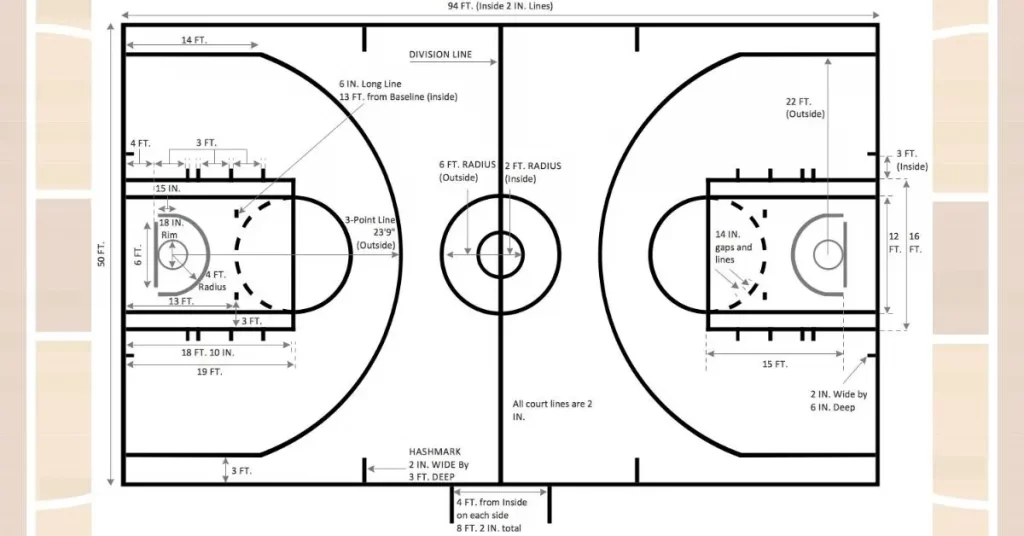
2. Number of Players
There are a total of 12 players playing in a match. Each team has 6 numbers of players from which only 5 players can actively play on the court. Remaining 1 player stays outside the basketball court and acts as a substitute for another player when needed.
3. Duration of the Game
As time is everything, knowing the rules and regulations about duration in a basketball game is a must. Different basketball leagues have changed durations. Particularly for the NBA, the match consists of four quarters and the duration of each quarter is about 12 minutes. If the game is tied, an overtime quarter of 5 minute occurs until the winner is declared. There’s also a break quarter of 2 minutes between quarters and a half-time of 15 minutes between 2 and 3 quarters. After the ball is thrown in-bounds the game clock will begin when the player touches it and when the ball goes out-of-bounds the game clock will stop. Moreover, the NFL has quarters of 15 minutes while NCAA instead of quarters has halves. Each half is 20 minutes.
4. Scoring
The main objective of basketball is trying to score the most by making shots in the basket of the team playing against you. However, each team tries to defend the scoring against each other constantly. Now let’s have a look at how the scoring system of a basketball game works.
- 3 Points: When a player puts the basketball through the hoop from behind the three-point line, the team will be given 3 points.
- 2 points: When a player shoots the ball through the hoop when he is inside the three-point line, the team will be given 2 points.
- 1 point: When a player scores a basket on a foul shot, the team will get 1 point against the other team.
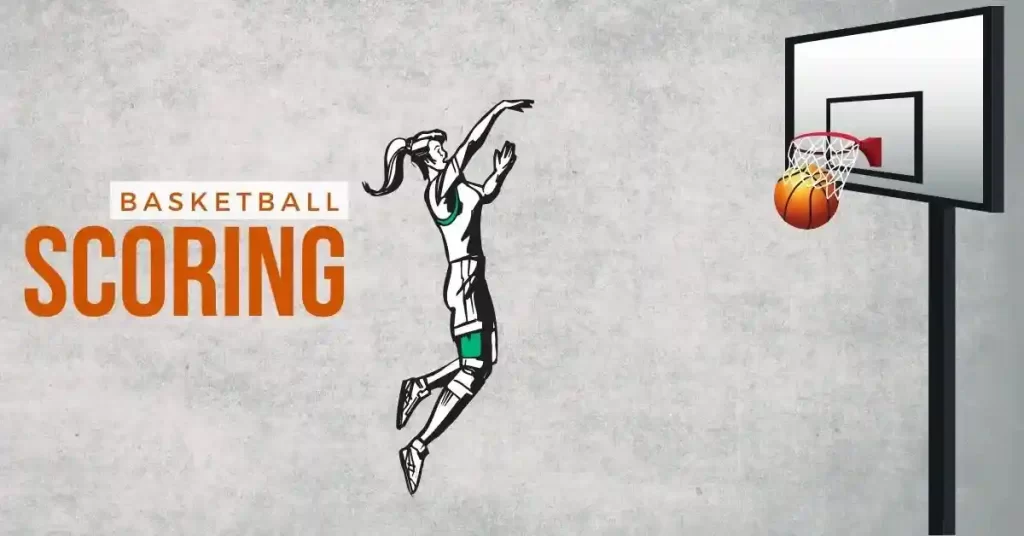
Team with the higher score at the end was declared the winner. But if game ties after 4 quarters, there will be an overtime quarter until one team is declared as the winner.
5. Position of Players
During the game, players get their positions the following way.
- Center: Centers are the tallest players. They are positioned near the basket and responsible for blocking defenders, known as picking or screening. And on defense, they keep opponents from shooting by blocking shots and passes in the key area.
- Forward: Next tallest players may be called upon for playing under the hoop and operate in the wings and corner areas. They are responsible to get free for a pass, take outside shots, drive for goals, and rebound. And on defense, they prevent drives to the goal and rebounding.
- Guard: Guard are the shortest players and they should be really good at dribbling fast, seeing the court, and passing. They bring the ball down the court and set up offensive plays. On defense, they steal passes, contest shots, prevent drives to the hoop, and for boxing out.
Let’s have a look towards the image given below, that is how players took position while playing basketball.
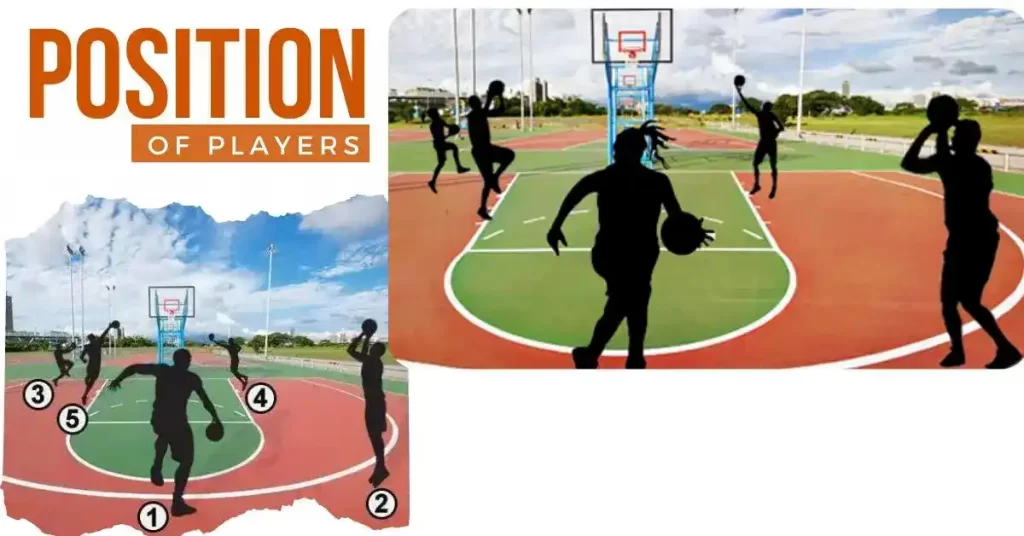
6. Rules for Defensive & Offensive Players
There are two defensive and three offensive players, in each of the teams. The rules and regulations for both offensive and defensive players are different that get conducted in the court. Let’s have a look at them.
Rules for Defensive Players:
- 3 Second Rule
Leagues like NCAA and NBA, applied the defensive 3 Second rule while The FIBA and High School league do not abide by this rule. According to this rule, a defensive basketball player shall not remain in the restricted area for more than 3 seconds.
- No Contact Rule
A defensive basketball player while guarding must not touch a player with the ball. On the defender’s part if he initiates a touch, it will result in a foul. See the below image.
Rules for Offensive Players:
- It’s essential to Stay within the periphery of the basketball court.
- Players can dribble the ball with only a single hand.
7. Goaltending
Goaltending is the violation of rules that occur in two ways i.e. offensive goaltending and defensive goaltending, while player interference with the ball on its way to the basket. Let’s have a look when it occurs.
- Offensive Goaltending
Offensive goaltending is less common than defensive goaltenidng.It happens when a player legally shoots the ball but his teammates does the following.
- Lay a hand on the rim when the ball is on the rim.
- Make contact with the net of the hoop when the ball is on the ring.
- Lay a hand on the rim while the ball is going downward through it.
As a result of all these, the opponent team will get possession of the ball and the offensive team will not get any score. See the image given below for getting how offensive goaltending works.
- Defensive Goaltending
Defensive goaltending is more common than the other one. It occurs the same way of offensive goaltending, but the only difference is a defender commits this type of goaltending to obstruct a shot of an offensive player to prevent them from clearing the ball from the basket. In this case, the offended team will get two points if the goaltending has happened from a two-point zone and three points if it happened in the three-point zone.
8. Fouls, Penalties, and Violations
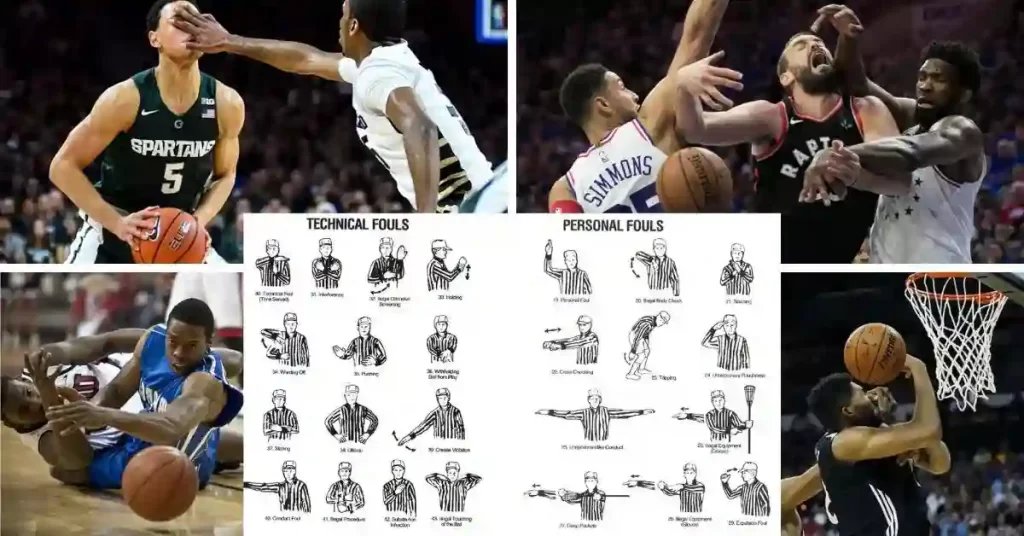
Fouls:
In addition to stealing the ball from the opposing team, there are many fouls, penalties and violations in basketball games that you should know.
Personal Fouls:
Personal fouls include any type of illegal physical contact with the opponent team. Such as hitting, pushing, slapping, holding and illegal picking/screening that happens when an offensive player is moving and he sticks out a limb as an attempt to block the path of the defender. See the images given below which shows personal fouls, happened during the match.
Technical Fouls:
This type of foul can be committed by a player or a coach. It doesn’t involve physical contact but it’s about the “manners” of the game. For instance, Foul language, obscene gestures, and even arguing with coaches and players is considered a technical foul. Some other types of technical fouls in basketball game are as follows. See the image given below.
- Holding up the game.
- Having players more or less than five in a team when the ball becomes alive.
- Defensive 3-seconds.
- Players hanging on the backboard or basket ring.
- A player participating in the game while he\she is not in the team’s active list.
- Smashing the backboard.
- Dunking during warm-ups or filling in the scorebook improperly.
- Coaches box violations.
Charging and Blocking:
Charging is an offensive foul committed when a player pushes or runs over a defensive player to steal the ball. As a result, the ball is given to the team to which the foul was committed. See the image for knowing how charging foul get committed.
Blocking is a defensive foul of illegal personal contact that occurs when defenders do not establish position in time to prevent an opponent’s drive to the basket. See below image for Blocking.
Penalties:
For the fouls during the basketball game there are some penalties. Let’s have a look at them.
- If a player is shooting while being fouled, he will get a free throw if his shot does go in, but he gets two free throws if his shot doesn’t go in.
- If the player is fouled while shooting for a three-point goal and they miss their shot, they get awarded with three free throws. And awarded with one free throw, if a player is fouled while shooting a three-point shot but makes it anyway. So, he can score four points on the play.
- If a team gets fouled while not shooting, the ball will be given to them at the nearest side or baseline, out of bounds, and have 5 seconds to pass the ball onto the court.
- If the team has committed seven or more fouls in the game then the player who has fouled will be awarded with one free throw. If he makes his first shot, then another free throw will be awarded to him.
- If the team has committed ten or more fouls then the fouled player will get two free throws.
Violations:
Walking/Traveling: During the basketball game you have to dribble all the time and taking more than ‘a step and a half’ without dribbling the ball is called traveling. Moreover, moving your pivot foot once you’ve stopped dribbling is also traveling. See the below image.
Carrying/palming: Carrying/palming is when a player dribbles the ball with his hand too far to the side of or, sometimes, even under the ball. See the below image for carrying/palming.
Held ball: Occasionally, two or more opposing players at the same time will get possession of the ball. In order to avoid a prolonged and/or violent tussle, on a rotating basis, the referee stops the action and awards the ball to one team or the other. See the image below of how Held ball can create a violent tussles.
Double Dribbling: It’s an illegal dribble in a basketball game, occurs when a player dribbles the ball with both hands concurrently or pursues to dribble after making the ball rest position in one or both hands.
In such a case, it’s a judgmental call for a dribbling violation. As a result, the opposition team will get the ball at the sideline which is closest to the dribbling breach, but not nearer to the baseline than the foul line broadening. However, there is also an exception to the rule, known as power dribble. So, the dribble can be used once or utilized after getting a pass in the lane.
Backcourt Violation: Backcourt violation occurs when an offensive team becomes unsuccessful to fetch the ball from backcourt to the frontcourt within eight seconds after getting possession. Thus, the opposing team inbounds the ball from the sidelines as the offensive team loses possession of the ball. See the below image.
In the case of a defensive team, this happens when defenders apply full-court pressure and one of their goals harasses the ball handlers to prevent them from crossing the half court in less than eight seconds.
Note: Before 2001-02, the time limit was 10 seconds to get possession of the ball in the NBA. Later, the NBA reduced the time limit just to bring more up-tempo style in the basketball game.
Time restrictions: A player passing the ball inbounds has only five seconds to pass the ball. But if he does not, the ball will be awarded to the other team. It also includes the rule in which a player can’t have the ball for more than five seconds when being closely guarded. In some states and levels, shot-clock restrictions require a team to attempt a shot within the given time frame.
Conclusion
I have clearly mentioned and explained all the rules and regulations of basketball that you should know while playing. Basketball can be played outdoors or indoors, so ensure to wear an appropriate uniform that includes a team’s jersey, shorts, socks and shoes. Also, the court has proper markings on it. Hope, you find this article beneficial and understanding for you.